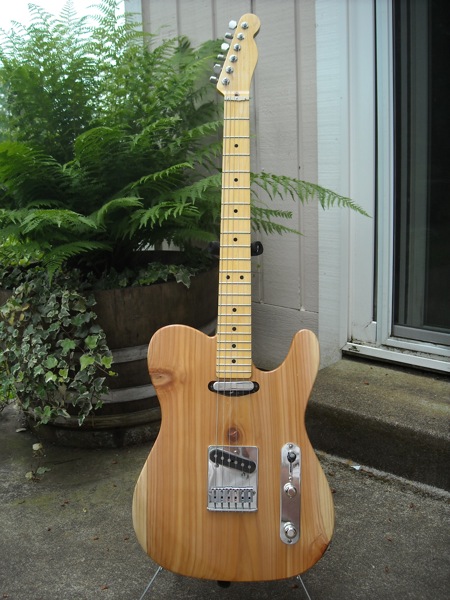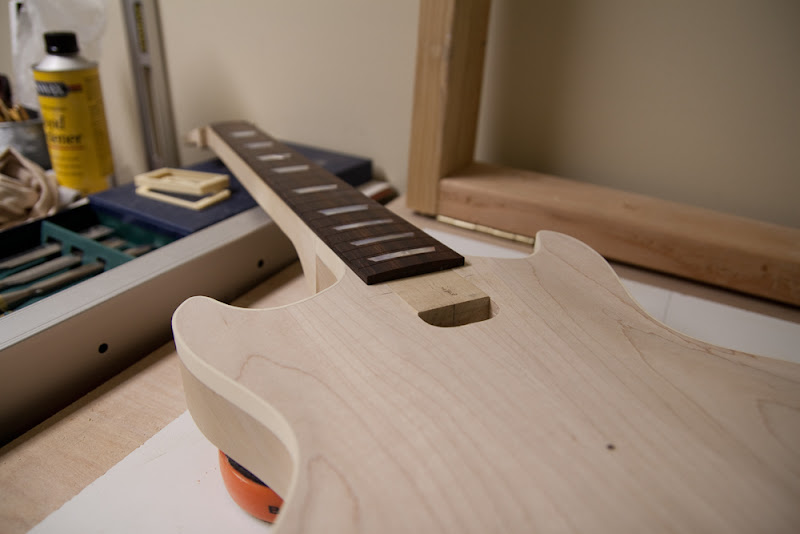telekazamm
Tele-Meister
I have some cedar that i think is western red cedar or aromatic cedar not sure ho to tell the difference, anyone used this on a tele before?


Mojo=silliness, particularly this coniferous slab-body fad.How much softer is cedar than pine, now a universally recognized tone wood of extreme vintage mojo?


I have some cedar that i think is western red cedar or aromatic cedar not sure ho to tell the difference, anyone used this on a tele before?
This is one I built out of Cedar. Blue dye on the redish cedar give a spectrum of different blues/greens to almost black depending on the light.
I built it for a friend who wanted the blue, I'd never have done that myself, but it looks great with the gold hardware. Sounds good and he loves it.
The wood is very soft to work with, but with finish it's fine. Certainly has no trouble being strong enough to hold the neck or screws for bridge/pickups/etc.




Problems with dry splitty timber may be attributable to over-ambitious kiln drying, tear-out due to router cutter direction: you have to go away from the grain on curves and ends.
It's too soft. It will shed screws and ding like crazy, and it will probably be a bear to get smooth. It is super easy to get smooth, and I have never had a problem with it stripping screws when handled properly, I usually just use a little bit longer screws in softer wood with proper pilot holes, and little bit of paste wax.
Stick to hardwood -- from deciduous trees. What? Some of the best sounding teles I have ever heard were made from soft woods.
I just got a Warwick Rockbass Streamer yesterday that despite obfuscating the body wood by a creative naming, turns out to be absolutely nothing but framing-grade spruce lumber, like from Home Depot.
Took it out of the box and the strap button pulled out in my hand. Body like balsa wood, stripped screws everywhere, rough finish, awful in every way.
$1300 (!!!) Chinese piece of utter crap.
It is an outstanding tonewood.Cedar is supposed to be a great tonewood. What with the relic craze, cedar and other soft woods should be very popular.
Aromatic cedar is fairly soft, and its right there with lightweight eastern and sugar pine on the softness scale. But its not like its going to fall apart if you look at it wrong.How much softer is cedar than...pine, now a universally recognized tone wood of extreme vintage mojo?
The 'ding' issue is why they make this stuff:
(link removed)
It says "for decayed or rotting wood" but I've seen/read about people using it on pine and fir solidbody guitars with good results.
I'm currently making a carved top that has a WR cedar body, with a maple cap. This is where I'm at currently:

WR cedar smells great, dings easily, and is brittle. Tearout was a problem with this one:

Where the grain is straight or quartersawn, those straight flute router bits love grabing hold and ripping chunks out! Walnut is just as bad. I use my oscillating spindle sander on troublesome areas and wood.
It's super light, though, and I imagine it'll be pretty resonant. For routing, take whatever your "shallow" pass is supposed to be, and reduce it a little more. Or maybe use a robosander. I also bought some bench cookies to rest it on while working on it, mostly to keep the bottom from scratching with every bit of dust.
I did pick up some of that Minwax wood hardener, and a fingernail test on some scrap has it increasing the dent resistance.
Yup, I know. I did, and also followed the "downhill" routing thing to the letter. Still tore out, since I was taking too deep of a cut, even though it was thin passes.
As for the overcooked kiln thing, that's certainly possible.